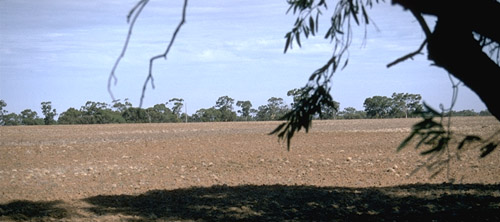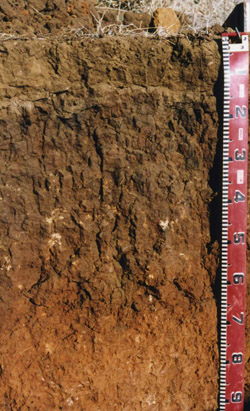LP29
| Property: Roadside Reserve, Gredgwin | Australian Soil Classification: Calcic, Mesonatric, Red SODOSOL |
| Northcote Factual Key: Dr 2.43 | Great Soil Group: solodic soil |
| General Landscape Description: Upper slope on a broad sandstone ridge crest with a southeasterly aspect. Original vegetation included Mallee, Grey Box (Eucalyptus microcarpa) and Buloke (Casuarina luehmannii). | |

LP29 Landscape
Soil Profile Morphology
Surface Soil
| A1 | 0-10 cm | Dark brown (10YR3/3); fine sandy clay loam; hardsetting surface condition; moderate coarse blocky structure; strong consistence dry; pH 8.6; sharp change to: |  LP29 Profile LP29 Profile |
| A2 | 10-12 cm | Conspicuously bleached (7.5YR7/2d); fine sandy clay loam; massive structure; sharp change to: | |
| Subsoil | |||
| B21 | 12-30 cm | Reddish brown (5YR4/4); heavy clay; strong coarse prismatic, breaking down to strong coarse blocky structure; strong consistence dry; pH 9.3; clear and wavy change to: | |
| B22k | 30-65 cm | Yellowish red (5YR5/6); heavy clay; same structure as above; strong consistence dry; contains a few (5%) soft carbonate in pockets; pH 9.4; gradual change to: | |
| B23 | 65-90 cm | Reddish yellow (5YR6/8); medium clay; moderate coarse prismatic structure; strong consistence dry; contains very few (<2%) amount of soft carbonate in pockets; pH 9.5; gradual change to: | |
| B3 | 90+ cm | Yellowish brown (10YR5/4) and yellowish red (5YR5/8); medium heavy clay; same structure as above; strong consistence moist; dark flecks (ferromanganiferous) common (10%); pH 9.3. | |
Key Profile Features
- Strong texture contrast between surface (A) horizons and the top of the subsoil (B21) horizon.
- Conspicuously bleached A2 horizon.
- Calcareous and strongly sodic subsoil.
Soil Profile Characteristics
pH | Salinity Rating | |||
Surface (A1 horizon) | strongly alkaline | very low | non-sodic | none1 |
Subsoil (25-45 horizon) | very strongly alkaline | low | strongly sodic | strong |
Deeper subsoil (1 m) | very strongly alkaline | medium | very strongly sodic | complete |
| 1 Slight dispersion with remoulding. | ||||
 |
Horizon | Horizon Depth | pH (water) | pH CaCl2 | EC 1:5 | NaCl | Exchangeable Cations | |||
Ca | Mg | K | Na | ||||||
Meq/100g | |||||||||
A2 | 10-12 | 9.3 | 8.2 | 0.25 | 12.7 | 9.3 | 1 | 4.1 | |
B21 | 12-30 | 9.4 | 8.5 | 0.43 | 9.2 | 11.8 | 1 | 5.9 | |
B22 | 30-65 | 9.5 | 8.6 | 0.73 | 6.2 | 11.8 | 1.2 | 8.4 | |
B23 | 65-90 | 9.3 | 8.7 | 0.9 | 5.2 | 9.7 | 0.8 | 8.5 | |
Horizon | Horizon Depth | Ex Al mg/kg | Ex Ac meq/100g | Field pF2.5 | Wilting Point pF4.2 | Coarse Sand (0.2-2.0mm) | Fine Sand (0.02-0.2mm) | Silt (0.002-0.02mm) | Clay (<0.002mm) |
A2 | 10-12 | 42.6 | 33.4 | ||||||
B21 | 12-30 | ||||||||
B22 | 30-65 | ||||||||
B23 | 65-90 |
Management Considerations:
Whole Profile
- The strongly alkaline profile suggests that some nutrients (e.g. phosphorus, iron, manganese and zinc) may be poorly available to some plants.
- The surface is non-sodic but disperses slightly after remoulding. Over stocking or excessive cultivation of the soil when wet may result in surface sealing and exacerbate the hardsetting condition.
- The surface also has a high fine sand content (38%). When cultivated in a dry condition, these soils will become "powdery" and subsequent rain may result in a surface seal development. Maintaining adequate organic matter is important to assist in reducing structural degradation (e.g. compaction and exacerbated hardsetting) on such soils. Practices such as minimum tillage, stubble retention and pasture rotation should be encouraged. Organic matter is also important in terms of soil fertility and water holding capacity.
- The top of the subsoil is strongly sodic and disperses strongly in water. This is likely to restrict water and root movement through the profile. Waterlogging is likely to occur after heavy rains. The presence of a conspicuously bleached A2 horizon above the sodic subsoil indicates that periodic waterlogging occurs.
- The subsoil salinity rating is medium at 90 cm depth in the profile. This may restrict the growth of deeper rooted salt sensitive species (eg. linseed, maize, faba beans, chickpeas, and some other legumes). Chloride salts were not measured for the site so it is not possible to get a full estimate of the salinity rating.


